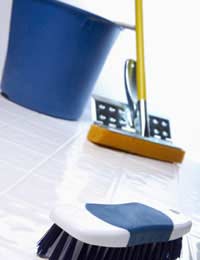How Do Disinfectants and Antiseptics Work?

Disinfectants and antiseptics do the same thing – they kill bacteria very rapidly on contact. A distinction between the two types of agent is made because disinfectants generally kill bacteria on surfaces, floors and non-living objects whereas antiseptics are used to kill bacteria on the skin of people or animals. Neither should be confused with antibiotics, drugs that are given to people or animals to kill bacteria inside the body.
Disinfectants
A wide range of different substances are used as disinfectants, including alcohols (also used as antiseptics), aldehydes, such as ortho-phthalaldehyde, bleaches based on chlorine compounds, hydrogen peroxide and also iodine (also another traditional antiseptic) and potassium permanganate solution. Phenolic compounds also have anti-bacterial activity and are often used in disinfectants bought for use in the home, and in disinfectant hand-washes and soaps.Different disinfectants work in different ways. Hydrogen peroxide, which reacts to produce free oxygen radicals and bleaches that are based on chlorine compounds are very powerful oxidising agents. They oxidise the complex molecules present on the surface of bacteria, causing their cell walls and cell membranes to disrupt. The proteins on the surface become irreversibly damaged and start to stick together forming clumps. This happens very quickly – a strong solution of sodium hypochlorite solution that is used to disinfect a toilet, for example, kills bacteria within seconds. The bacterial cell cannot respond to the damage quickly enough and the whole cell simply splits open and dies.
Recent research has shown that bacteria do have some capacity to resist an attack by bleach. Contact with hypochlorous acid was found to switch on a gene in some bacteria that is part of the pathway that bugs use to cope with heat stress and bleach-like substances that cells of the immune system produce to fight off infection. If the concentration of bleach solution is low, bacteria with genes that resist this sort of cellular attack might be able to survive cleaning.
Antiseptics
Antiseptics are placed on the skin, usually in an area where the skin has been damaged, such as a cut or a graze. They are also used to clean the skin before intentional cuts are made in surgical operations. Those that kill bacteria outright are described as bactericidal. Other antiseptics, described as bacteriostatic, stop bacteria from growing or dividing, but do not kill them.Common antiseptics used during the last 150 years or so include alcohol, boric acid, hydrogen peroxide, iodine, carbolic acid and other phenol compounds, chlorohexadine, sodium chloride, sodium hypochlorite and calcium hypochlorite. The latter is also known as chlorinated lime and was used by Ignaz Semmelweis in the 1840s when he tried to prevent puerperal fever spreading in a maternity ward in Vienna.
The widespread use of antiseptics did not really begin until the 1870s, due mainly to the work and publications of the English surgeon Joseph Lister. The link between bacteria and disease was made around that time and Lister pioneered the use of antiseptics before, during and after surgery, which was also a new technique at the time.
Modern Use
Disinfectants and antiseptics are now used extensively in hospitals and other medical treatment centres, where they help to maintain a clean environment that can prevent the spread of bacteria from person to person. Disinfectants and antiseptics used properly are still able to kill bacterial strains that have become resistant to antibiotic treatment.In the last 20 years, the use of disinfectants such as anti-bacterial sprays has increased in the home but this may not necessarily be a good thing. The vast majority of bacteria in our home environment are friendly bacteria and do not cause disease. Using anti-bacterial products all over the home is probably unnecessary. Cleaning danger areas such as toilets, drains and rubbish bins with a suitable disinfectant or bleach solution is very likely to be sufficient.
- Bacterial Vaginosis: An Embarrassing Problem
- What is Toxic Shock Syndrome?
- What is a Strep Throat?
- What is Otitis Media?
- Bacteria That Fix Nitrogen
- Bacteria That Infect Plants
- Bacteria That Deal With Pollution
- Do Bacteria Cause the Common Cold?
- Bacteria That Recycle Nutrients
- Useful Bacteria in Food
- Bacteria in the Home
- Bacteria and Sex
- Bacteria and Tooth Decay
- Bacteria and Food Hygiene


Re: Friendly Bacteria in the Digestive System
hello, thankyou for this website it was very helpful
Re: Friendly Bacteria in the Digestive System
nope im leaving now goodbye , mumm! crimble crumble ready?
Re: Friendly Bacteria in the Digestive System
The meat out of the bin is perfectly fine jackie!
Re: Friendly Bacteria in the Digestive System
Yeahhh jim not the right time were quite busy at the moment
Re: How Can People Catch Lyme Disease?
My symptoms of Lyme disease occurred in 2017, but was diagnosed in 2019. I had severe symptoms ranging from headache,…
Re: Friendly Bacteria in the Digestive System
kids
Re: Friendly Bacteria in the Digestive System
i like kids
Re: Friendly Bacteria in the Digestive System
I have yo kidz. i have the basement kids
Re: Friendly Bacteria in the Digestive System
oh god im out
Re: Friendly Bacteria in the Digestive System
uhm